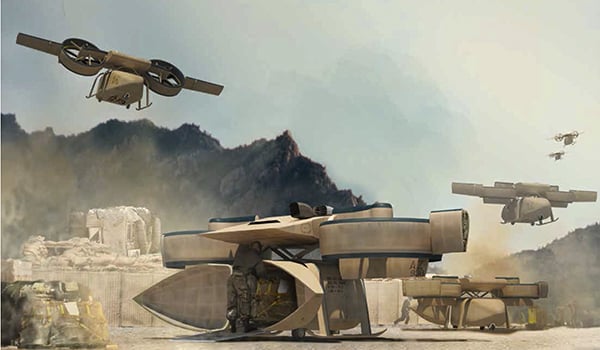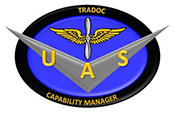
Unmanned Aircraft Systems / By COL Paul A. Cravey: To meet the demands of the future strategic environment the Army must be able to achieve an enduring requirement: rapidly deploy task-organized combined arms forces able to transition quickly and conduct operations of sufficient scale and ample duration to achieve strategic objectives. During the Vietnam era, to do this, the Army innovatively integrated an emerging technology of the time, rotary wing platforms, with ground maneuver forces and fire support to increase its reach, protection, and lethality. As it was in the 1970s, to dominate in today’s and tomorrow’s multi-domain environment, the Army must continue to integrate new technologies, doctrinal innovation, and new organizational structures to accomplish future missions and objectives.

PIASEKI AIRCRAFT CORP. GRAPHIC
The development and proliferation of advanced anti-access and area denial (A2/AD) capabilities such as long-range precision fires, air defense systems, electronic warfare, and unmanned aircraft systems (UAS) challenge the ability of our Nation to project power onto land from the air and maritime domains. In order to counter this threat, we must be able to operate dispersed and rapidly concentrate maneuver formations to isolate the enemy, attack, and seize upon fleeting opportunities. Much like the integration of the helicopter in Vietnam, the Future Family of Unmanned Aircraft Systems (FUAS), fully integrated with air and ground maneuver formations, can provide the necessary reach, protection, and lethality to win tomorrow’s battles.
 Future UAS Employment Concepts
Future UAS Employment Concepts
How will future UAS adapt to support maneuver on the future battlefield? The cornerstone of this future UAS capability is a family of controllers – aircraft agnostic and ranging in size from handheld “smart phones” and larger vehicle and aircraft mounted variants to fixed-station control platforms. Regardless of size, each of these control variants will be capable of distributed, tailorable control of aircraft and payloads and receipt of sensor imagery at myriad locations from Echelon Above Division (EAD) down to Soldier level. Some examples of employment concepts:
- Aerial intelligence units and Special Operations Forces in theater could employ advanced ISR and precision attack payloads from a UAS launched and recovered from a CONUS-based UAS control station.
- Sustainment operations may entail loading and launching a cargo unmanned aircraft (UA) from a brigade resupply point and autonomously maneuvering to a forward-deployed “holding pattern.” Control of the cargo UAS is handed-over to a dismounted Soldier at a forward deployed unit for maneuvering/unloading in the terminal area then returned to the pre-planned “holding pattern” until the brigade resupply point resumes control of the cargo UAS for recovery and landing.
- A tactical vehicle assigned to a combat aviation brigade (CAB) may launch and recover multiple aircraft. After launching, the operator could conduct aircraft and/or payload handover to an artillery spotter using a hand-held device or to an AH-64 crew until finished with their respective battle-damage assessment or reconnaissance missions. Once UAS and payload control returns to the mobile vehicle control station, the mobile UAS operator could dynamically re-task the aircraft in support of troops in contact, handover to the next pre-planned users or recover to the CAB.
- These examples illustrate the capabilities needed from the Army’s UAS control interfaces in the future operational environment (OE): multi-UA control to multiple locations with a suite of aircraft agnostic, permission-based, scalable, variants of controlling aircraft and payloads and receiving sensor imagery. Figure 1 depicts a notional FUAS concept with emphasis on scalable control capable of managing, controlling, and using multiple Army UA throughout the OE.

Notional Future Family of Unmanned Aircraft Systems (FUAS) concept / TCM-UAS GRAPHIC
Modernization Strategy
The question becomes, “How do we get there from here?” The Army UAS modernization strategy provides a blueprint for future Army UAS capabilities and nests within the Training and Doctrine Command (TRADOC) Robotics and Autonomous Systems (RAS) strategy and Army warfighting concepts. The UAS modernization strategy, formally written as the Family of Unmanned Aircraft Systems Initial Capability Document for DoD approval, was born out of numerous threat and capabilities-based assessments, holistic UAS reviews, and insights and lessons learned from combat operations. It assesses for Army and Joint leaders the risks to operational effectiveness of capability gaps inherent in current Army UAS and highlights the additional and different capabilities required in the future.
What Future UAS Must Provide for Tomorrow’s Success
The Future Family of UAS (FUAS) deploys with tactical formations, has the mobility to provide continuous support to maneuver formations and requires flexible, agile UAS leaders and Soldiers. Tomorrow’s Soldiers will be required to perform a wide range of complex tasks in support of reconnaissance, surveillance, manned/unmanned teaming and attack missions, and will need formidable, flexible tools. Future UAS will optimize Soldier performance by automating most tasks, allowing appropriate focus on the mission at hand by leaders and Soldiers rather than maneuvering the aircraft. As the Army moves forward to the “Next Fight,” FUAS will include a suite of tactical unmanned aircraft capable of providing the right multi-mission capabilities for maneuver, fires, intelligence, mission command and sustainment. Key required capabilities of future UAS include:
- Globally employable and expeditionary UAS formations
- Survivable against near-peer threats and in contested/denied environments
- Increased speed, range, endurance, payload capacity, and reliability (but at affordable prices)
- Able to operate and team with dismounted personnel and manned ground and air platforms in all scenarios and environments
- An open, configurable architecture that allows for both UAS control and the distribution of sensor data into the mission command and intelligence enterprises over dispersed areas and extended ranges
- Adaptable, scalable, permission based control that enables manned/unmanned teaming across the full range of warfighting functions
- Multiple payload capability sets optimized for each air vehicle group (small, tactical, medium altitude endurance) according to space, weight, and power available;
- Payloads capable of rapid integration using standardized payload interfaces with minimal reconfiguration requirements
Path to Future Success
Our modernization efforts must stay ahead of the known and the uncertain. This will not only demand equipment that optimizes human performance but more importantly, will require well-trained leaders and Soldiers enabling the Army and Joint Forces to fight and win against a broad array of emerging threats. Development of a FUAS that allows Soldiers to control unmanned aircraft using scalable devices employing a variety of multi-purpose unmanned aircraft and payloads will provide commanders unparalleled flexibility, dynamic situational awareness and improved decision-making cycles.
The Future Family of UAS will be capable of operations in extreme, austere environments and will help ensure the success of our forces. These transformational technologies, employed by the most highly trained Army in the world, will ensure that tomorrow’s Soldiers will never be alone or unprepared so long as they are equipped with “A Soldier’s Best Friend.”
COL Paul A. Cravey is the U.S. Army Training and Doctrine Command Capability Manager for Unmanned Aircraft Systems (TCM-UAS) at Fort Rucker, AL.
























